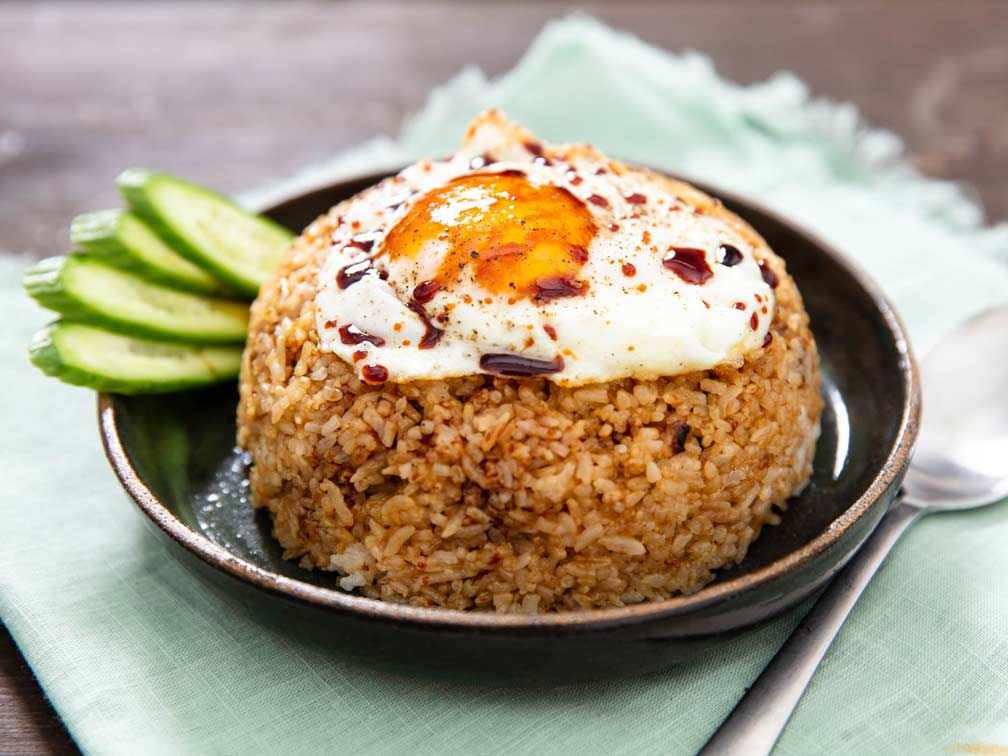
(Source: SilverKris: A quick guide to Penang’s street food)
Your alarm goes off. Oh no! It’s 8am and your lecture is in 30 minutes. After brushing your teeth and putting on the last clean outfit you have left, you head out of your hostel room. But before you head to class, your stomach grumbles. Surely you can’t focus on intense subjects on an empty, rumbling stomach. So then, what is there to eat?
These 5 Malaysian breakfast foods will keep your tummy happy and give you the energy you need to make it through the day.
#1 Nasi Lemak

Main Ingredients: Steamed coconut and pandan leaf rice, hard boiled egg, samba, dried anchovies, peanuts, and cucumber.
Nasi Lemak is a flavourful staple dish among all people in Malaysia. The focal point is the coconut milk steamed rice, accompanied by a rich and spicy sambal (chili paste), a hard-boiled egg, dried anchovies, and cucumbers. All of these ingredients are then wrapped in an aromatic pandan leaf, usually in a pyramid shape.
Many people also enjoy adding a protein component such as ayam goreng (fried chicken), sotong sambal (chili cuttlefish), or beef rendang (stewed beef).
Best of all, most places sell nasi lemak for only RM1 or RM2! Perfect for those on a tight budget looking for a delicious breakfast that won’t break your budget.
#2 Roti Canai

Main Ingredients: Dough, Ghee, Water, Dal (on the side)
Similar to paratha in South Asian cuisine, roti canai is a flat bread made of dough, ghee, and water, which is then repeatedly kneaded and folded until layers within the dough are formed. Its then cooked on a flat grill and served with dal (lentil soup) and curry.
There are no shortage of roti canai variations. They can be filled with egg (roti telur), onions (roti bawang), cheese (roti cheese), and condensed milk (roti boom) and a range of other combinations. Roti is usually paired with an omelette (telur dadar) or chicken, beef, or fish curries.
Roti Canai are usually the cheapest food item at your neighbourhood Nasi Kandar or Mamak restaurant, which are restaurants of Indian origin but that have evolved into iconic Malaysian mainstays.
#3 Mee/Bihun Goreng

[Source: Resepi Bihun Goreng Resepi Mak Che Nom]
Main Ingredients: Mee (Yellow noodles) or Bihun (Rice noodles), Dark Soy Sauce, Chicken, Cabbage and other vegetables.
Who doesn’t love a bowl of noodles in the morning, or anytime for that matter? For Malaysians, Mee Goreng (fried noodles) or Bihun Goreng (fried vermicelli) hits those morning munchies just right. Both of these dishes involve frying up noodles with soy sauce, shallots, garlic, and then stir frying in vegetables, eggs, and chicken or seafood. Sambal is typically served on the side and adds spiciness for those who enjoy a bit of heat. Breakfast hawker stalls charge between RM2-5 ringgit for this dish, depending on quantity.
#4 Roti Kaya Bakar with Soft Boiled Eggs

Main Ingredients: Toasted White Bread, Kaya spread, Eggs
For a breakfast that’s a little less greasy and equally delicious, toast and eggs are a solid option. A classic breakfast originating from Hainanese immigrants working on British ships, Roti Kaya Bakar has been popular in Singapore and Malaysia since the early 20th century. The dish is quite simple - White bread is toasted with creamy and slightly sweet kaya (coconut) spread, and served with 2 soft, runny boiled eggs that are topped with a bit of soy sauce and white pepper. It pairs very well with coffee, tea, or milk and is also great as a mid afternoon snack! Kaya toast can be found at normal eateries for RM5-10 as a set with coffee but varies depending on the swankiness of the café you’re eating it.
#5 Nasi Kicap Telur

(Source: Seriouseats)
Main Ingredients: Rice, Soy Sauce, Egg
It’s the end of the month, your bank balance only has 2 digits, and it will be a few days until you have money to spend – desperate times calls for desperate measures. However, desperation does not mean you can’t eat deliciously cheap. Enter the last dish on this list – Nasi Kicap Telur.
Nasi Kicap Telur is exactly what the dish is made out of: Nasi (White Rice), Kicap (Soy Sauce), Telur (Egg) – in other words, White Rice with Soy Sauce and Egg. No fancy or expensive ingredients from gourmet gastronomy outlets required, just 3 simple ingredients you likely have in your kitchen or pantry. The sweetness of the soy sauce coupled with the creamy yolk blend together and infuse onto the rice, giving each bite the impression that it took more time to prepare than it actually did. Remember, low budget does not mean less tasty!
